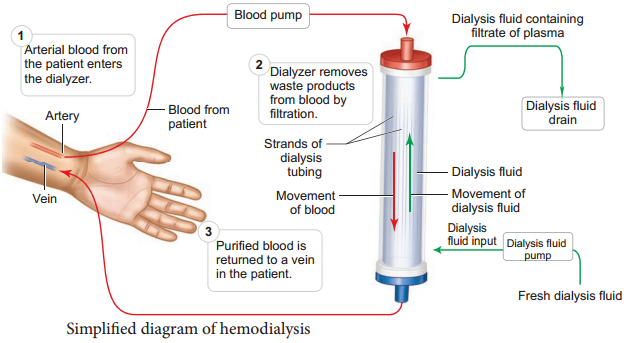Learninsta presents the core concepts of Biology with high-quality research papers and topical review articles.
Process of Haemodialysis and its Kidney Transplantation
Malfunctioning of the kidneys can lead to accumalation of urea and other toxic substances, leading to kidney failure. In such patients toxic urea can be removed from the blood by a process called haemodialysis. A dialyzing machine or an artificial kidney is connected to the patient’s body.
A dialyzing machine consists of a long cellulose tube surrounded by the dialysing fluid in a water bath. The patient’s blood is drawn from a conveinent artery and pumped into the dialysing unit after adding an anticoagulant like heparin.
The tiny pores in the dialysis tube allows small molecules such as glucose, salts and urea to enter into the water bath, whereas blood cells and protein molecules do not enter these pores. This stage is similar to the filtration process in the glomerulus.
The dialysing liquid in the water bath consists of solution of salt and sugar in correct proportion in order to prevent loss of glucose and essential salts from the blood. The cleared blood is then pumped back to the body through a vein Figure 8.10.

Kidney Transplantation
It is the ultimate method for correction of acute renal failures. This involves transfer of healthy kidney from one person (donor) to another person with kidney failure. The donated kidney may be taken from a healthy person who is declared brain dead or from sibling or close relatives to minimise the chances of rejection by the immune system of the host. Immunosuppressive drugs are usually administered to the patient to avoid tissue rejection.
Haemodialysis is a way of replacing some of the functions of your kidney, if your kidneys have failed, by using a machine to filter and clean your blood. Blood is pumped out of your body to the machine where it is passed through a series of tiny tubes, in an ‘artificial kidney’ or ‘dialyser’.
In hemodialysis, blood is removed from the body and filtered through a man-made membrane called a dialyzer, or artificial kidney, and then the filtered blood is returned to the body. The average person has about 10 to 12 pints of blood; during dialysis only one pint (about two cups) is outside of the body at a time.
There are three different types of dialysis. Hemodialysis. Hemodialysis is the most common type of dialysis. Peritoneal dialysis. Peritoneal dialysis involves surgery to implant a peritoneal dialysis (PD) catheter into your abdomen. Continuous renal replacement therapy (CRRT).
When your kidneys fail, dialysis keeps your body in balance by: removing waste, salt and extra water to prevent them from building up in the body. keeping a safe level of certain chemicals in your blood, such as potassium, sodium and bicarbonate helping to control blood pressure.
Hemodialysis is a procedure where a dialysis machine and a special filter called an artificial kidney, or a dialyzer, are used to clean your blood. To get your blood into the dialyzer, the doctor needs to make an access, or entrance, into your blood vessels. This is done with minor surgery, usually to your arm.
The Benefits of Hemodialysis Include:
- Nurses perform treatments for the patient.
- Regular contact with other hemodialysis patients and staff.
- Patients usually only have three treatments per week; giving them four days off.
- No equipment or supplies have to be kept at home.
- In an emergency, medical help is available quickly.